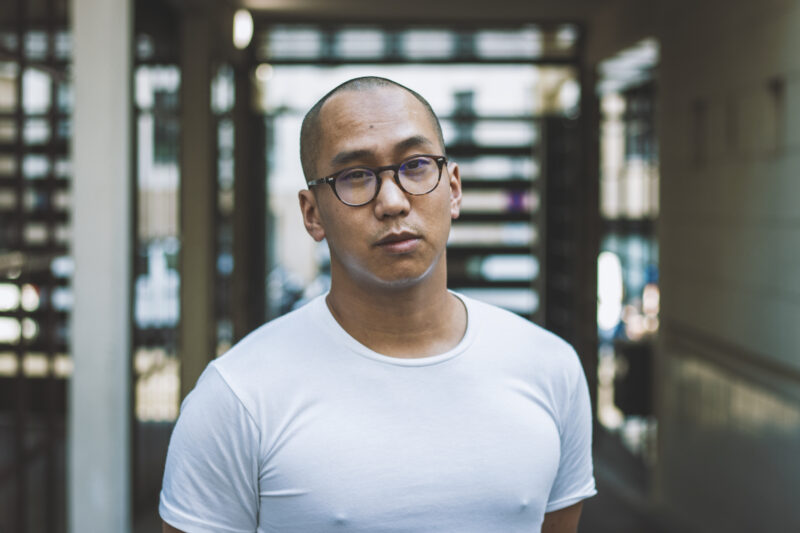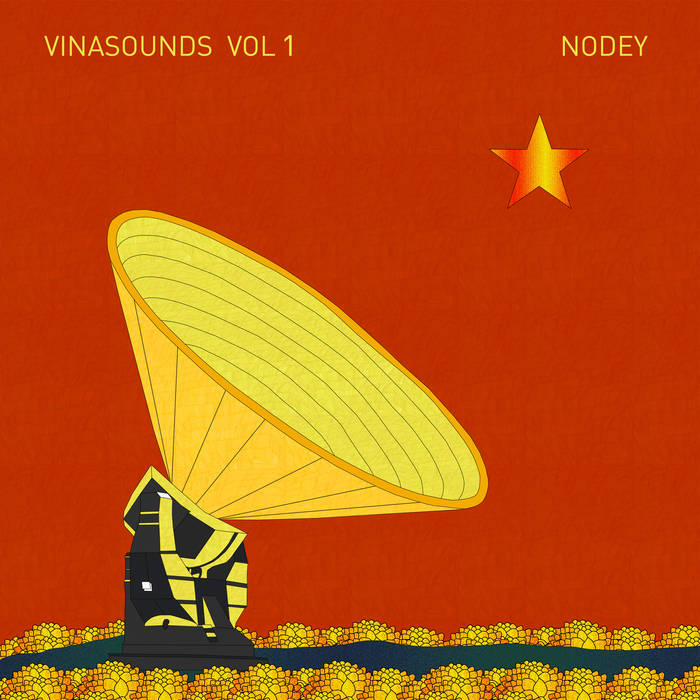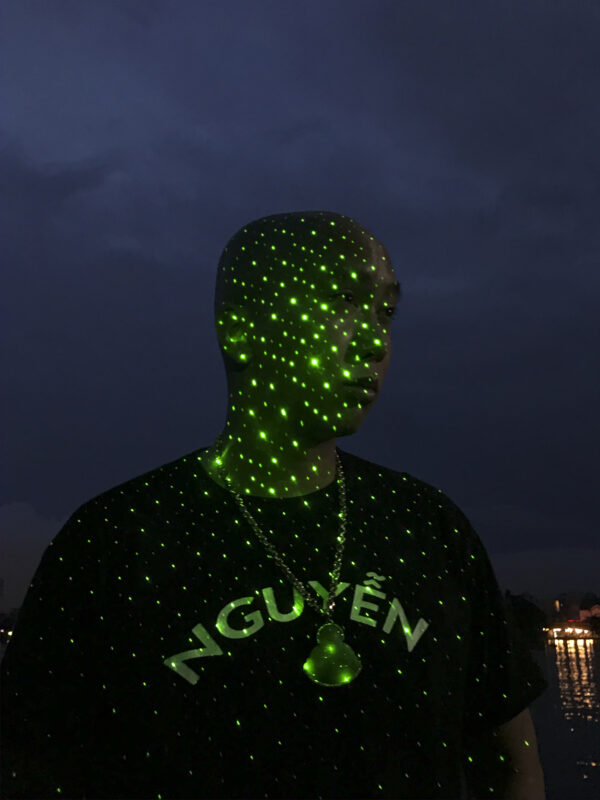
“We must be careful of being new colonisers, like: ‘let me teach you how to live.’ Honestly, I don’t pretend to develop Vietnam. For me it’s a trade, I build my own thing, and by doing so, if it can help some people in Vietnam, then it’s great. I’m not the Red Cross.” – Nodey
~
Dôn Nguyễn grew up in the banlieues of Paris, but these days, the producer better known as Nodey calls Ho Chi Minh City home. Though he has come a long way, he can still trace his hip-hop trajectory from his first encounter with the genre as a teenager in Europe: MC Solaar’s “Bouge De Là.” The track was so popular, he says, even his parents were familiar with it.
But the song that marked an important milestone in the producer’s thinking of French rap was “Tonton du Bled [Uncle from the Land]” by 113. Produced by DJ Medhi in 2000, “Tonton du Bled” sampled “Harkatni Eddamaa” by Ahmed Whabi. 113 rapper Rim’k, who drew upon the yearnings and desires of first-generation Algerian immigrants, tapped into the nostalgia of a home far away and a desire to return—if only for a visit—a wish left unfulfilled in the 90s as Algeria was ravaged by civil conflict. For Nodey the track signalled that one can be French and a non-Black migrant and find a voice in hip-hop.
Solomon Thomas theorised that youths in Turkey did not take their hip-hop cues from the United States, but rather they are facilitated through Berlin-based Turkish hip-hoppers who have “culturally reterritorialised US hip-hop in the process of developing diasporic identities.” Likewise, Algerian youths from the Parisian suburbs were just as paramount in reterritorialising hip-hop for all non-Black youths in France. Internationally, rap became an important vehicle for society’s frustration against the injustices dished out by the state.
“French colonial history, and its postcolonial movements, has made the French territory a globalisation lab,” says Nodey in The Nodey Process, a documentary following his career. “People from different communities, origins, and beliefs, have to coexist in the same territory. This is where it gets interesting. French rap is a music where guys express their anger toward France and their institutions, but they will do it with Moliere’s language. This love-hate relationship is interesting.”
Reflecting on his years of making beats for rappers and battles, Nodey describes his earlier work, where he sampled older American musical cultures, as something that did not sit well with him: “I used to sample American music, jazz, soul music. I am good at this, I know how to sample. I know the classics, I know the Philly music, I know the Temptations, Curtis Mayfield, etc. But DJ Premier, and all the biggest hip-hop producers do that because they sample the music they have at home. They pick up their parents’ vinyls and take that. I realised, wow, why do we just copy the Americans, it’s not my culture, it’s an importation. I just copied their identity, the American identity.”
To embark on making his own hip-hop, he was invited to work with Youssoupha, a well-known French rapper, producing the track “Public Enemy.” But it was “Chanson Française [French Song]” where he suddenly gained attention from the larger Francophone hip-hop community. For the song, a crackling feminine hum of a pre-1975 singer occasionally interspersed by a “như một lần.” Nodey lifted both samples off a 7-inch vinyl taken from his family’s collection and weaved it throughout the track, with a sample of “Hey Ton Ton” from the aforementioned 113 track, “Ton Ton du Bled”.
When I ask him if he has always used Vietnamese samples in his work, he concedes: “It’s funny. I think so. it’s really strange my link with Vietnamese music, because I never thought about that, I never tried to conceptualise.” For his Vinasounds vol1 EP Nodey turned the Vietnameseness up a notch. The production on Vinasounds chops whole songs and separate notes apart to create a new melody, rhythm and bass. He also tends to take certain words, or combinations of words, and distorts them sonically. The EP contains five songs, all of which use instruments that are common in traditional Vietnamese music. The song “Quê Mẹ [My Motherland]” is a reimagining of a popular source of inspiration and sentimentality in art and the Vietnamese national psyche, that being the “Quê,” or hometown. The song samples the phách, a common percussive instrument in ca trù, and the đàn bầu, which is then chopped up, where it is then reconstituted into a new melody. It also features autotuned vocals from singer Hương Thanh. The added effect of the echo leaves the yearning to return, imagined or real, to one’s quê mẹ lingering in the air for that much longer.

He describes his visits to Vietnam before the release of Vinasounds as limited. Despite this, Vietnam has allowed him to reencounter music that feels closer to home. In their work with young Vietnamese Americans, Yen Le Espiritu and Thom Tran coined “symbolic transnationalism”, a process whereby second generation migrants engage transnationally with the homeland “through imagined returns to the homeland through selective memory, cultural rediscovery and sentimental longings”.
Impressed with Nodey’s work, Youssoupha offered to sign him as an in-house producer for Bomaye Musik, an independent record label the rapper co-founded with Général Philo. The opportunity would have given him security and a steady stream of work. Nodey describes the difficult conversation he had with Kinhassa-born Youssoupha, who was increasingly spending the majority of his time in Abidjan, wanting to shift artistically towards Africa and its diaspora, in terms of inspiration and focus. Nodey, who at the time, saw himself as a French-born artist with Vietnamese roots, was flattered to have been offered the opportunity, but he felt he could not be at home in this new environment Youssoupha wanted to build. He had the double-edged sword of not wanting to take up space in an evidently Black space as well as a need to go on a journey of his own.
Feeling creatively empty, he decided to give away all his possessions and leave France. He was able to take up a residency in Shanghai for six months. At times, he felt out of place as many of his peers went to prestigious art schools or had degrees from elite universities. But it was a period of important learning and unlearning for Nodey. It gave him the time and space to work on his first full album « 🙂 ».
The album signaled a shift for his own work; he moved away from more of the conservative hip-hop traditions and took on a myriad of influences from his travels across Asia. On the album’s first track, “Krishna -{•:-o”, Nodey travelled to Varanasi, an ancient city on the banks of the Ganges river, where he met Saiam, a local traditional singer. Nodey played him a beat, which the singer said reminded him of a 900-year-old Soufi poem, “Zehaal E Miskeen.” For the album, Nodey made a conscious decision to not use English in any of his songs, wanting to push back against the tide of Englishness dominating global pop. Specifically, he wanted to distance himself from the American pop culture dominating the world.
The next residency he took was in Saigon, at the Villa Saigon, l’institute francais. It was there where he met rapper Suboi. They made a track together. “Đôi Khi ❤,” heavily influenced by cloud rap, is about the uncertainties of love, a jump into the future of doubt with questions where one does not know the answers:
Đôi khi em trông thấy anh
đôi khi lại không
Đôi tay ta ôm lấy nhau
không đi về đâu
(sometimes I see you,
sometimes I don’t,
our hands embracing,
into nowhere”.)
Nodey calls Suboi an artist who places great importance on her lyrical mastery, whereas Nodey himself is still struggling to grapple with the Vietnamese language. While he acknowledges that lyrics are important, he most likely will not understand their meaning. He says he entrusts lyrics to rappers, but it is his job to ensure the lyrics sound good to his ears; in his words, “I design the shape of the sounds”.
For “Đôi Khi ❤,” I was fortunate to sit in on part of the recording. Nodey made subtle suggestions on pace, intonation, delivery of a lyric, such as how the monosyllabic “không” or “đâu” is delivered across multiple syllables, transforming this innocuous word into another layered digital instrument. “Đôi Khi ❤” is the last track on the album, as Nodey sees this as the end to this journey, one which he set off on when he left Paris creatively and emotionally drained.
Another artist Nodey was interested in was Soolking, a rapper whose style sits somewhere between auto-tuned Francophone rap and Algerian raï. Across all his songs Soolking has over a billion total views on YouTube, but Nodey says it is unlikely he would appear on popular French TV or Radio stations. Soolking’s breakout hit “Guerilla,” a song about the experiences of an undocumented migrant, samples the 1982 Algerian raï track “Ya Zina Diri Latay (Pretty Girl, Serve the Tea),” something that many young Algerians who would have grown up listening to their parent’s music would be familiar with.

Nodey speaks of the bridge that Soolking built across borders and generations—the ability to modernise familiar classics while acknowledging the past whilst forging ahead creatively, that process of innovation and excitement not too heavily weighed down by the past. I asked Nodey if he thinks we will ever see a French-Vietnamese, (or any diasporic Vietnamese artist for that matter) who would be able to close that generational and cultural gap that Soolking has been able to do, Nodey lets out an elongated “Wooooow,” followed by, “that’s a really good question, but I feel, I hope it will, I think it will. I think Vietnamese creatives, and Asians to in large, in France are a little late, compared to North African communities.” He outlined the importance of visibility of predecessors like Rachid Taha, a popular rockstar who started out in the 80s, and that compounded effect on young French youths with familial links to the Maghreb. Nodey also raises the important difference between France’s former colonies in Africa and Asia, the issue of a lingua franca. Vietnam by doing away with French as a language has effectively cut off an important linguistic vehicle that allows connections to be made between these two places.
Having fully settled and fathered a daughter with Suboi, who is known in the Western press as the Queen of Hip-hop, (a moniker she hates) Nodey is energised by his new home, and excited by what’s happening in the creative scene and what his peers are doing. On sampling, he says a good sample “has to have a good texture, it has to give you a good feeling, a good touch in your ear, a good massage in your ear.” He elaborates: “all samples are from the past, and they are important markers of memory and I like to play with memory.” One sound he wants to sample is the sound of trucks. Trucks, which shuttle goods across the country, driven by low paid workers, represents how Saigon moves fast, it is an apt symbol for hyper consumerism and globalisation. They are only allowed to drive in the city at night, as Saigon has a lot of ports right in the centre of the city coupled with poor infrastructure.
He spoke of his excitement in using Vietnam and the surrounding environment in dictating his new production. When I asked him how different it would be to his Vinaounds Vol 1, he said that it was largely based on musical samples from his parent’s generation. Music contained on physical tapes and vinyls, limited in form and format, but also heavily steeped in memory and the disjuncture of diaspora. The “here and then.” He will seek to not just be influenced by contemporary Vietnamese music or from a wider pool of music that is accessible, but he seeks to be moved by the everyday and the lived experience, like the aforementioned lorries, he spoke of being excited about discovering art and literature on his own terms and in his own time. The ‘here and now.’
Recently, the local Vietnamese music scene has been gaining a lot of attention throughout the world. With NTS Radio, Mixcloud, Pitchfork, Boiler Room TV, DJ Mag amongst others now regularly spotlighting up and coming musicians from Vietnam. He speaks highly of Nhạc Gãy, a collective formed by a mixture of returnee and local Vietnamese, which holds events and even released a record, Nhạc Gãy Tổng Hợp Số 1. His own contribution to the album, “49 Days of Quarantine,” gives insight into his next creative direction. He heavily samples the kèn đám ma, an instrument normally played at funerals, with a Vinahouse adjacent production. Now that he has been in Saigon, he’s excited to work with emerging artists to redefine a new and modern Vietnam.
In terms of identity, he also sees that there has been a change in how he sees himself. He is no longer French with Vietnamese roots, something the French encouraged its emigres to think. Today, Nodey sees himself as something more complex, constantly changing, never static, always a process.
 Cường Minh Bá Phạm works between sound and community, sometimes they intersect, and at times they don’t. He finds himself trying to constantly negotiate and situate himself concerning cultural identity, movement, sites of community, and geographical spaces, Often this is done through sound, language, or memory. He is also actively involved in East and Southeast Asian communities in London, primarily working with local refugee and precarious communities. At the moment, he is working alongside a Steering Committee in setting up the An Viet Archive which consists of the largest known collection of documents, photos, and other objects relating to the British-Vietnamese experience. Under the handle ‘Phambinho’ he also hosts a monthly show on NTS, an independent online radio platform, in which he, and occasional guests, attempts to reframe “Asia” as a contested paradigm through the lenses of music and art.
Cường Minh Bá Phạm works between sound and community, sometimes they intersect, and at times they don’t. He finds himself trying to constantly negotiate and situate himself concerning cultural identity, movement, sites of community, and geographical spaces, Often this is done through sound, language, or memory. He is also actively involved in East and Southeast Asian communities in London, primarily working with local refugee and precarious communities. At the moment, he is working alongside a Steering Committee in setting up the An Viet Archive which consists of the largest known collection of documents, photos, and other objects relating to the British-Vietnamese experience. Under the handle ‘Phambinho’ he also hosts a monthly show on NTS, an independent online radio platform, in which he, and occasional guests, attempts to reframe “Asia” as a contested paradigm through the lenses of music and art.


